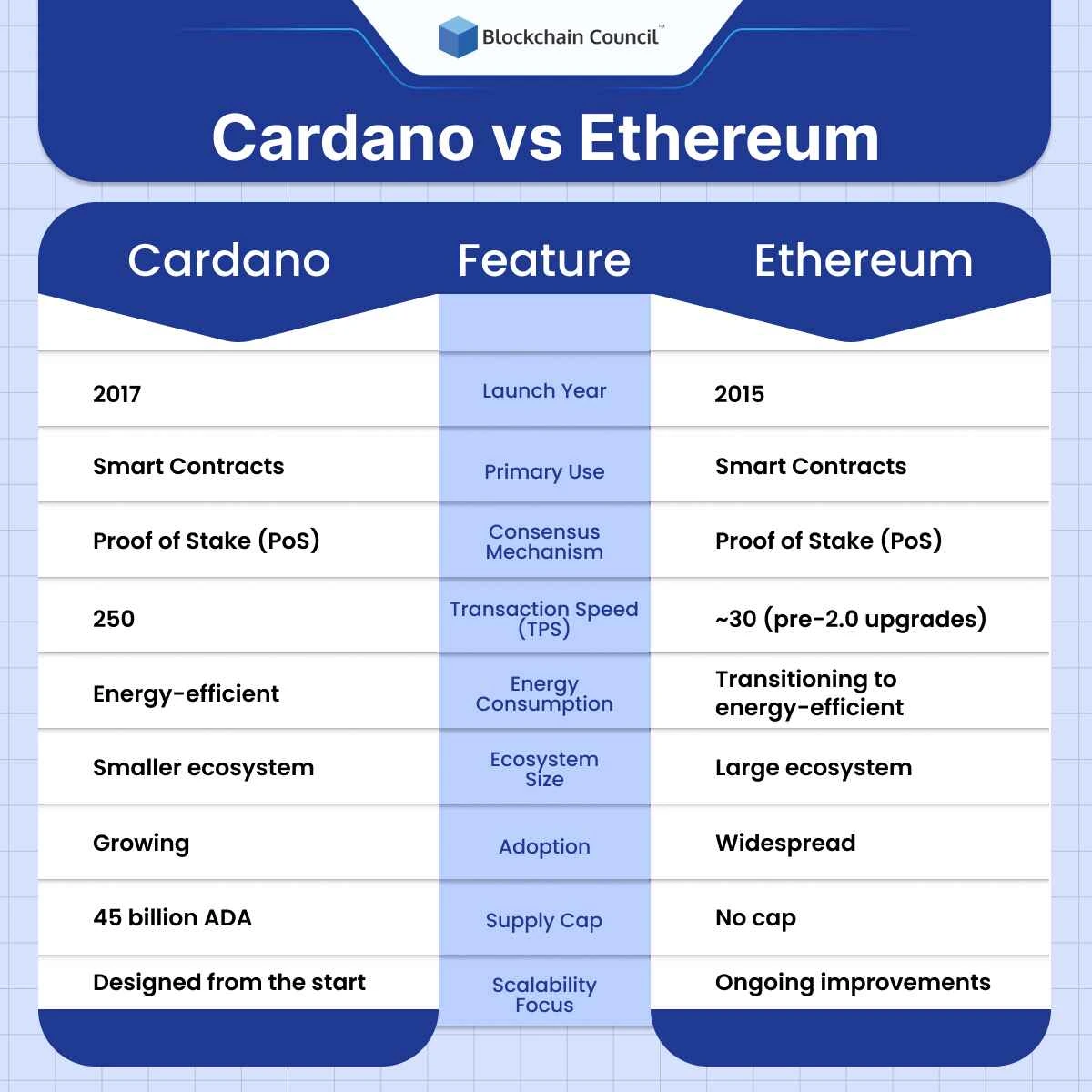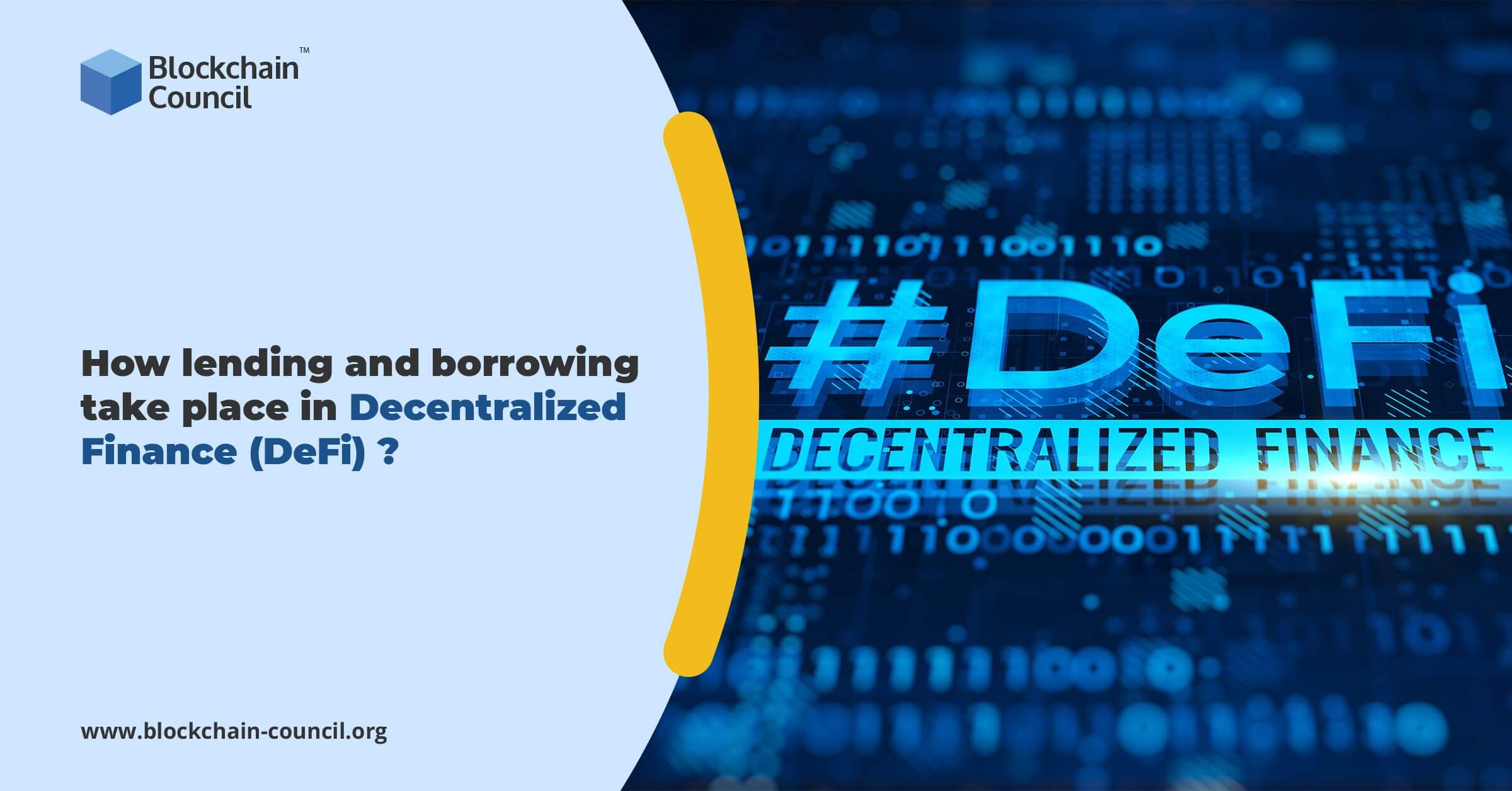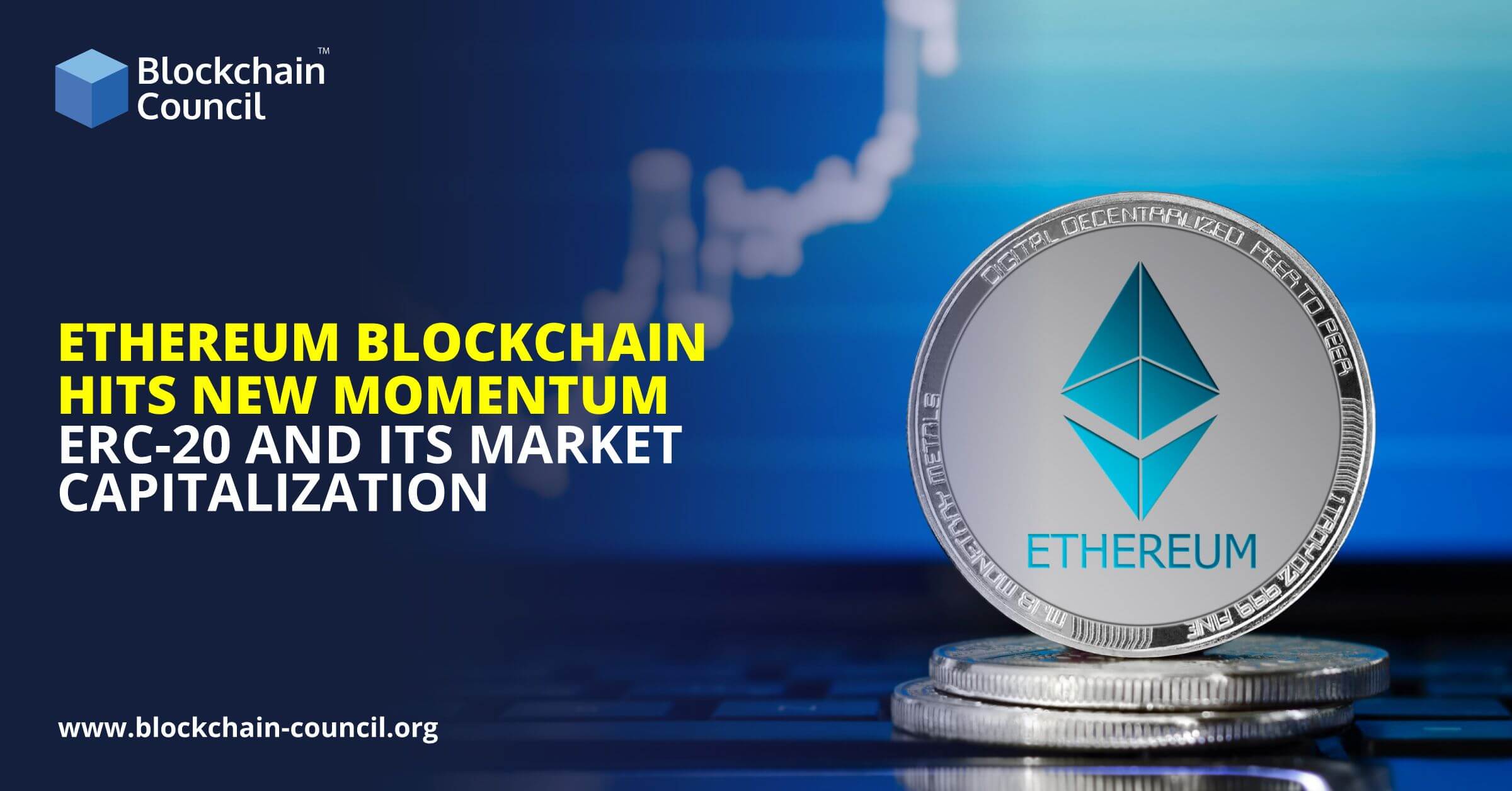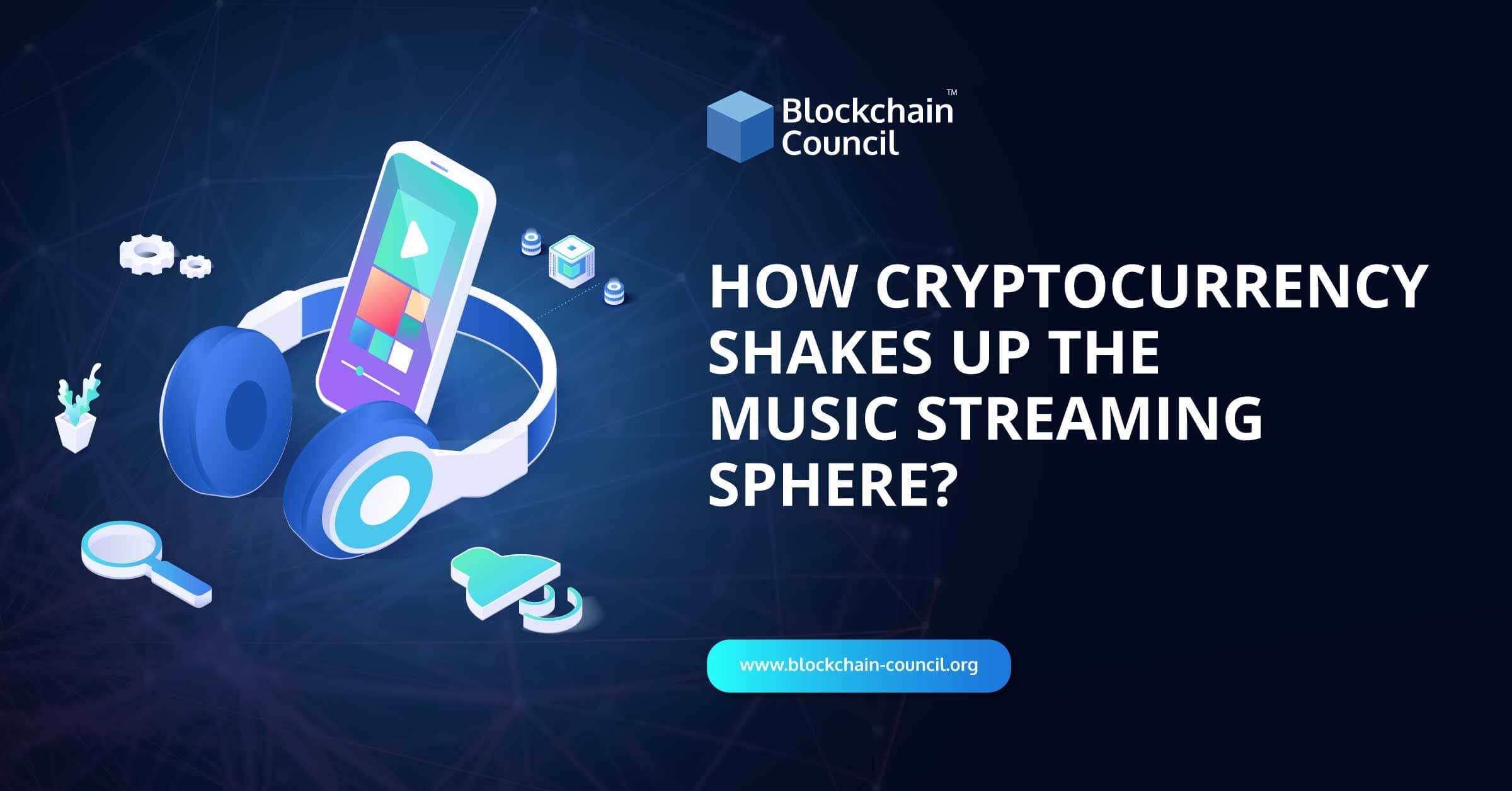
- Blockchain Council
- October 25, 2024
Cardano (ADA) has become a major player in the Blockchain space and cryptocurrency industry. In fact, it is the fifth-largest Blockchain for NFT trade volume.
What is Cardano (ADA)?
Cardano (ADA) is a decentralized Blockchain platform built to allow secure, scalable, as well as sustainable digital transactions. It is recognized for its distinct method and seeks to solve issues faced by earlier Blockchain systems like Bitcoin and Ethereum. Cardano is often referred to as a “third-generation” Blockchain because it seeks to build on the strengths of those earlier platforms while improving key areas like scalability, sustainability, and interoperability.
Launched in 2017, the platform supports decentralized applications (dApps) and smart contracts, much like Ethereum, but with a design focused on scientific research and peer-reviewed academic principles. Instead of using the traditional proof-of-work system, Cardano operates on a proof-of-stake model, which helps it to be much more energy-efficient and environmentally conscious.
ADA is the native cryptocurrency that powers the Cardano network. It powers transactions, pays for transaction fees, and is also used in staking, where holders can help secure the network in exchange for rewards.
Who Are the Founders of Cardano?
Cardano was founded in 2015 by Charles Hoskinson, who had earlier contributed to Ethereum’s development. He wanted to create a more secure, scalable, and sustainable Blockchain network than what was available at the time. He teamed up with Jeremy Wood, another former Ethereum team member, to establish Cardano.
This partnership resulted in the creation of three main organizations: the Cardano Foundation, IOHK (Input Output Hong Kong), and Emurgo. IOHK focuses on the platform’s research and technical development, Emurgo works as a venture arm supporting commercial adoption, and the Cardano Foundation manages the ecosystem and promotes adoption across different sectors.
How Does Cardano Work?
Cardano uses a proof-of-stake system called Ouroboros. Unlike proof-of-work systems, where miners compete to solve cryptographic puzzles, Ouroboros allows stakeholders to validate transactions and create new blocks based on the amount of ADA they own and have staked. This approach consumes less energy and doesn’t need high computational power. So, it is more environmentally friendly.
Participants who own ADA can either become a validator (or “slot leader”) and process transactions or delegate their tokens to others who are performing this function, earning rewards in the process. This incentive system encourages widespread participation and ensures that the network remains decentralized.
Cardano also separates its Blockchain into two layers: the Cardano Settlement Layer (CSL), which handles transactions, and the Cardano Computation Layer (CCL), which runs smart contracts. This separation allows for more flexibility and security, as upgrades to one layer don’t affect the other.
What are Cardano Layers?
As noted, Cardano’s structure is based on a layered system that keeps the settlement layer (for ADA transfers) separate from the computation laye. The latter handles smart contracts and decentralized apps.
The Settlement Layer (CSL)
The Cardano Settlement Layer (CSL) is where ADA transactions occur. It is designed to handle the transfer of value securely and efficiently. This layer is responsible for recording all transactions on the network, using the e-UTXO (Extended Unspent Transaction Output) model, which enhances transaction processing by allowing parallel execution. This makes Cardano capable of processing multiple transactions at once without affecting other parts of the system, similar to how Bitcoin manages transactions but with additional features like smart contracts.
The Computation Layer (CCL)
The Cardano Computation Layer (CCL), above the settlement layer, oversees smart contracts and decentralized applications (dApps). By keeping smart contracts separate from the transaction layer, Cardano can process both types of operations independently, reducing congestion and enhancing scalability. This division also supports various programming languages and tools. It simplifies the process for developers to create and launch dApps on the network.
The CCL allows developers to create smart contracts using formal verification, ensuring that they function as intended before execution. This high level of precision is critical in sectors such as finance and healthcare, where errors can have significant consequences.
The Technology Behind ADA
Cardano’s technology is rooted in scientific research, distinguishing itself as one of the few Blockchains built on peer-reviewed research. The development process is driven by experts in cryptography, mathematics, and engineering. Ouroboros, Cardano’s consensus method, is the first PoS system to be mathematically verified as secure. This level of security is what distinguishes Cardano from many other Blockchain platforms.
The Blockchain uses Plutus and Marlowe, specialized languages for writing smart contracts, designed to offer greater flexibility and security. Plutus is used for general-purpose smart contracts, while Marlowe is more focused on financial contracts. The Cardano platform is continually evolving with upgrades like the Vasil hard fork, which improved its transaction speed and scalability by optimizing the execution of smart contracts.
A significant recent innovation is the Hydra layer-2 scaling solution, designed to boost Cardano’s transaction throughput. This allows the network to handle a higher volume of transactions without sacrificing decentralization or security, positioning Cardano for broader adoption in various industries. The platform has seen growing use in fields such as supply chain management, education, and government services, with countries like Ethiopia adopting its technology to create digital identity systems for their citizens.
Cardano Eras – Explained
Cardano operates through a systematic and structured approach to Blockchain development, with its progression divided into five distinct eras:
Byron
The Byron era laid the foundation of the Cardano network. Initially, the network operated in a federated model, meaning a central group controlled it. This stage focused on creating the settlement layer that handles ADA transactions. Users could send and receive ADA during this period, but the system’s functionalities were limited to basic operations. Byron was essentially the network’s startup phase.
Shelley
Shelley shifted Cardano towards decentralization. It introduced the ability for users to stake their ADA tokens and participate in the operation of the network. Shelley marked a significant leap in making Cardano more decentralized, as more nodes became responsible for transaction processing. This era also made staking and earning rewards through the network more accessible to ADA holders, encouraging broader participation.
Goguen
The Goguen era brought smart contracts to the Cardano network, expanding its potential significantly. This phase enabled developers to create decentralized applications (dApps) on the Blockchain. It provided new possibilities in different fields like finance, healthcare, and supply chain management. It also introduced native tokens, meaning that developers could create their tokens directly on Cardano without needing smart contracts for token issuance.
Basho
Basho focuses on optimizing Cardano’s performance. As more users and applications started relying on the network, scalability became critical. Basho brought in methods and tools to improve transaction speed and efficiency. This one allowed the system to process more transactions per second while maintaining security and decentralization. The goal of this phase is to ensure that Cardano can manage a rising number of applications and users effectively.
Voltaire
Voltaire focuses on governance and sustainability. During this era, the power to make decisions regarding network upgrades, funding, and development will be handed over to the Cardano community. ADA holders can vote on proposals, and the network will operate with a decentralized governance structure. This phase aims to make Cardano self-sustaining, with decisions made by the community for the community.
What Makes Cardano Unique?
Cardano (ADA) stands out among other Blockchain platforms primarily due to its foundational emphasis on scientific research and peer-reviewed development. Unlike many Blockchains that launch with minimal planning, Cardano’s entire design follows a research-driven approach. Every update or feature it implements goes through academic scrutiny, ensuring that the technology is robust, secure, and scalable. This process distinguishes Cardano from Blockchains like Bitcoin and Ethereum, which often adopt a more “move fast, break things” strategy.
Another distinguishing element is Cardano’s Ouroboros protocol. Unlike many Blockchains that rely on energy-intensive Proof-of-Work (PoW) mechanisms, Cardano uses a Proof-of-Stake (PoS) system. This allows validators to secure the network by staking ADA tokens rather than solving complex cryptographic problems. As a result, it’s not only more energy-efficient but also encourages decentralization, as any ADA holder can participate in staking.
What Gives Cardano (ADA) Value?
Cardano’s value derives from several key aspects.
The main use of ADA is for transaction fees, staking, and governance within the network. When users perform transactions or engage with smart contracts on the Cardano Blockchain, they pay fees using ADA. These fees help maintain the platform’s security and keep it running smoothly.
Another factor contributing to ADA’s value is the staking mechanism. People who own ADA can assign their tokens to staking pools and receive rewards in return. This gives them a reason to keep holding the cryptocurrency. In addition, the staking process helps protect the network, making it stronger and more decentralized. Cardano also operates on a decentralized governance system, which lets ADA holders vote on proposals related to the network. This gives the community a direct role in deciding how the platform develops.
ADA’s value is also influenced by its initial coin offering (ICO), which was conducted over a period of about 16 months, from September 2015 to January 2017. During this period, approximately 26 billion ADA tokens were sold at a price of $0.0024 each, raising a total of $62.2 million. This sale accounted for about 57% of the total ADA supply. Investors were able to purchase ADA using Bitcoin, which allowed Cardano to gain significant attention in the cryptocurrency space.
Moreover, Cardano’s partnerships and real-world applications also enhance ADA’s value. The platform has established various collaborations, including those with governments and organizations focused on improving transparency and efficiency through Blockchain technology.
How Many Cardano (ADA) Tokens Are in Circulation?
Cardano has a maximum supply of 45 billion ADA tokens, but not all of these are in circulation yet. As of 2024, about 35 billion ADA tokens are circulating, with the remainder being held for various purposes, including future staking and development. The initial distribution of ADA was carefully structured during the ICO, with approximately 57% of the total supply being sold to early investors.
Out of this, 2.5 billion ADA tokens were allocated to IOHK, the development company behind Cardano, while 2.1 billion ADA went to Emurgo, the entity responsible for promoting and developing business applications on Cardano. Additionally, around 648 million ADA tokens were given to the Cardano Foundation, a nonprofit organization tasked with overseeing the growth and adoption of the Cardano platform.
How Is the Cardano Network Secured?
Cardano ensures its security through a combination of advanced technologies, with its core being the Ouroboros consensus mechanism. This method is a proof-of-stake (PoS) system, designed to protect the network against threats while maintaining energy efficiency. Unlike traditional proof-of-work systems, Ouroboros requires participants, known as validators, to hold and stake ADA (the native token) instead of expending energy to solve complex mathematical puzzles. These validators are randomly selected to create new blocks, ensuring fairness and decentralization. The more ADA a participant stakes, the higher their chance of being selected, but this process remains tamper-resistant due to a rigorous multi-party computation protocol.
Ouroboros was developed based on peer-reviewed research, making it unique in the Blockchain space for its formal academic foundations. It incorporates various layers of security, including cryptographic techniques that ensure block validation remains secure even if some network participants act maliciously. This layered approach contributes to its claim of provable security, an important factor in establishing trust in the Cardano network.
In addition to Ouroboros, the network uses an extended UTXO model (e-UTXO), which improves upon Bitcoin’s UTXO structure by adding smart contract compatibility. This model boosts security by making transactions more predictable and verifiable without compromising scalability. Overall, these mechanisms, combined with continuous research and updates, keep the network robust and secure for decentralized applications and financial transactions
How is Cardano Used?
Cardano has several uses in the Blockchain space. A main one is serving as a platform for decentralized applications (dApps). Developers can build various applications on Cardano’s Blockchain, taking advantage of its smart contracts functionality. These contracts allow users to automate complex agreements without needing intermediaries, which has significant applications in industries like finance, healthcare, and logistics.
Cardano’s native token, ADA, plays a key role in the system. It is used to cover transaction fees, ensuring everything runs smoothly. Users can also stake ADA to help validate the network’s transactions and, in return, earn staking rewards. This incentivizes community participation and strengthens the decentralized nature of the platform. Beyond staking, ADA can be traded on major cryptocurrency exchanges as a financial asset, much like Bitcoin or Ethereum. Investors hold ADA for speculation, long-term growth, or to participate in governance, where ADA holders have voting rights on key proposals related to the network’s development.
Another prominent use case of Cardano is within supply chain tracking. Various companies leverage the Blockchain to improve transparency and traceability across their supply chains, ensuring authenticity and reducing fraud. The platform is also employed in identity verification systems, especially in regions where centralized systems are less reliable. This helps individuals gain access to financial services and other important facilities.
How To Choose a Cardano Wallet?
Choosing the right wallet for ADA is a crucial step for users who want to hold, stake, or participate in the network. Cardano provides a variety of wallets to suit different users’ needs and experience levels.
- Daedalus Wallet: This is Cardano’s official full-node wallet. It provides a complete copy of the Blockchain, allowing for maximum security and transparency. Because it downloads the entire Blockchain, it requires more storage and is suitable for users who prioritize full control over their funds and want to participate actively in the Cardano network as a validator or in governance.
- Yoroi Wallet: For users who prefer a lighter alternative, Yoroi is a convenient browser-based wallet. It doesn’t require downloading the entire Blockchain, making it faster and easier to use. Yoroi is user-friendly and supports staking. So, it is a good pick for beginners.
- Hardware Wallets: For added security, many people choose hardware wallets like Ledger or Trezor. These devices keep private keys offline, reducing the chance of hacking or malware. Users who hold large amounts of ADA or plan to store it long-term often choose this option due to its strong security features.
When choosing a wallet, users should consider factors like ease of use, the level of security they need, and whether they want to participate in staking.
Can I Make Passive Income with Cardano?
Yes, generating passive income through Cardano is possible, primarily by staking ADA tokens. Staking lets users help secure the network and keep it running, while also earning rewards. Here’s how you can do it:
- Hold ADA: First, acquire ADA by purchasing it from a crypto exchange.
- Choose a Wallet: You need a compatible wallet, such as Daedalus or Yoroi, where you can securely store your ADA tokens.
- Delegate to a Staking Pool: Instead of directly staking, you can delegate your ADA to a staking pool. These pools pool together users’ resources to boost the likelihood of validating a block. This leads to higher staking rewards.
- Earn Rewards: The pool that successfully validates blocks receives rewards, which are then distributed to its participants. You will receive ADA as rewards based on the amount you staked.
You don’t need to run a stake pool yourself to earn rewards. Instead, you can delegate your ADA to an existing pool. This makes it easy for individuals to participate in staking without the technical know-how required to manage a pool. The expected annual return on staking ADA varies but is generally around 4% to 6%, making it an appealing option for those looking to earn passive income.
Cardano Partnerships
Cardano has made notable strides in building strategic partnerships to expand its reach. Below are some key collaborations:
- World Mobile: Cardano’s ongoing collaboration with World Mobile focuses on improving internet access for unconnected populations. This partnership leverages Cardano’s Blockchain to provide decentralized infrastructure for telecommunications.
- Arbitrum and Mina Protocol: Cardano is working with Arbitrum and Mina Protocol to enhance scalability and privacy features. Mina’s addition introduces Zero-Knowledge Proof. It allows Cardano to process more transactions while staying efficient..
- Polkadot: Cardano has also partnered with Polkadot to work on interoperability solutions, aiming to enable seamless communication and transactions across multiple Blockchains. By utilizing Polkadot’s Substrate framework, Cardano seeks to become a hub for interoperable Blockchain systems
- New Balance: New Balance is a global footwear brand. Through this collaboration, Cardano was used to authenticate products, ensuring that customers could verify the authenticity of their New Balance shoes by tracing their origins on the Blockchain.
- Dish Network: Cardano has also partnered with Dish, a telecommunications giant, to explore decentralized identity solutions and provide secure Blockchain-based services.
- Veritree: This partnership focuses on environmental sustainability, using Blockchain to track reforestation efforts. Cardano provides the underlying technology to verify and monitor tree-planting initiatives.
Cardano vs Ethereum
Cardano vs Bitcoin
Price forecasts for Cardano
As of October 17, 2024, Cardano’s price hovers around $0.34 to $0.38. Predictions for its price movement are mixed, reflecting a variety of factors like technological upgrades, market sentiment, and broader regulatory landscapes.
In the short term, experts expect moderate growth for ADA. By the end of 2024, it is likely to trade between $0.41 and $0.49. This conservative estimate stems from anticipated network upgrades like the full implementation of the Chang hard fork, which could improve governance and scalability features.
For the longer term, projections suggest ADA could see more substantial gains, especially if broader market conditions remain favorable. By 2025, ADA might trade between $0.50 and $0.80, reflecting increased utility from DeFi and smart contracts. Some forecasts predict ADA reaching a value between $1.20 and $2.00 by 2028, driven by its growing ecosystem and improved scalability through updates like Hydra.
Looking further ahead, some analysts believe ADA could reach a price of $3.50 to $5.00 by 2030. This optimism is based on Cardano’s focus on technological advancements, its commitment to decentralization, and potential regulatory support. But market changes and rivalry from other Blockchains could still influence these forecasts. Therefore, while Cardano holds promise, investors should consider the risks involved.
Latest Updates
Cardano continues to advance with new upgrades and projects. The Chang Hard Fork, introduced earlier in 2024, marks a new phase for Cardano, particularly in terms of governance. This update introduces a two-phase process that aims to fully implement on-chain governance, allowing ADA holders to have a more significant role in decision-making processes. One of the key changes involves Delegated Representatives (DReps), a new role that allows ADA holders to delegate their voting rights to trusted representatives.
Cardano’s governance framework is evolving as well. The Voltaire era is introducing community-driven governance mechanisms, where stakeholders have more control over protocol upgrades and network direction. This period marks Cardano’s effort to become a fully decentralized and self-sustaining system.
The Bottom Line
Cardano offers a forward-thinking approach to Blockchain technology. As of today, the platform has processed over 100 million transactions and facilitated the creation of over 10 million native tokens. With continued development in dApp support, governance, and scalability solutions, Cardano is solidifying its place as a strong competitor in the cryptocurrency world.







































































 Guides
Guides News
News Blockchain
Blockchain Cryptocurrency
& Digital Assets
Cryptocurrency
& Digital Assets Web3
Web3 Metaverse & NFTs
Metaverse & NFTs
